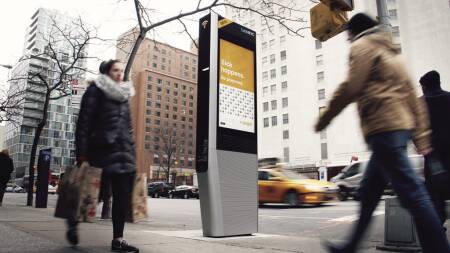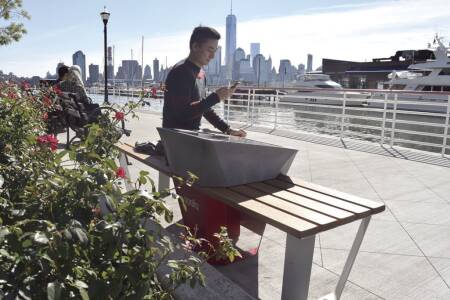Nearly everyone today carries a smartphone or tablet—or sometimes both—wherever they go, and they increasingly expect to be able to charge those devices and connect to the internet wherever they wish. Many places already oblige them. Dozens of downtowns offer free public wi-fi hotspots, and numerous national retail chains—Starbucks, Panera Bread, and Whole Foods, to name a few—offer free wi-fi access, too.
Yet, many private companies, including real estate developers and property owners, still do not fully understand how to build business models around free public wi-fi and device-charging stations. It is considered an added cost, and the return on investment is not always directly apparent.
But that is changing. Property-based service is seen as part of the next generation of growth in free public wi-fi. Technology research company ABI Research estimates that total public wi-fi hotspot deployments across the globe will more than double in the next five years, from 5.7 million in 2015 to 13.3 million in 2020. One of the new ways that free public wi-fi and charging stations are being deployed is through outdoor public furniture and fixtures—benches, shelters, streetlight poles, trash cans, and other common features.
These deployments are starting to appear on city streets in some major metropolitan areas, and now some real estate properties are beginning to experiment with them as amenities for tenants and customers. The effort is benefiting from a burgeoning number of cities and entrepreneurial companies in the United States and abroad that are creating these furniture products and fixtures for public wi-fi and charging station services.
Startup companies Soofa and Strawberry Energy, among others, have installed “smart” benches with solar-powered charging stations in parks and on streets in cities across the United States and Europe. In New York City, a partnership of companies has begun replacing thousands of pay phones with wi-fi and charging-station kiosks, and a company called Bigbelly Solar has been piloting street-corner garbage/recycling bins that sport solar-powered wi-fi hotspots. A U.K. cable company, Virgin Media, created wi-fi hotspots from specially designed manhole covers in Chesham, a town on the outskirts of London. And a telecommunications company in the United Arab Emirates, called du, plans to deploy solar-powered wi-fi hotspots around Dubai in artificial palm trees in parks and on beaches.
“There are so many opportunities in wi-fi today. We’re only just scratching the surface of what’s possible,” wi-fi consultant Claus Hetting told industry leaders at the Wi-Fi Innovation Summit in Copenhagen in December 2014. “All indicators point to the conclusion that we’re in the Wi-Fi Age right now.”
In an interview, Hetting elaborated on the opportunities with street furniture. “I’m guessing that street furniture will become hotspots over the next three to five years,” he says. “Locations with a lot of foot traffic, like outdoor malls, will be the most attractive. It will start with the biggest companies and properties that have the resources to develop and maintain such networks and services.”
As this trend accelerates, both the public and private sectors are gaining a better understanding of how they might profit from free public wi-fi and charging stations.
Why Wi-Fi?
Wi-fi is a service that uses unlicensed telecommunications spectrum for internet access. That makes it slightly different from the government-licensed spectrum that telecommunications carriers and service providers install through telecom towers, small cells, and distributed antenna systems. The ever-increasing surge of smartphone and tablet users and the explosion of data traffic from video streaming are choking the carriers’ infrastructure, leading to spotty broadband connectivity in some outdoor sites, especially office complexes. Wi-fi provides an alternative that can be installed by non-telecom third parties, such as the owners and managers of individual real estate properties.
“The reality is that because of the physical architecture, business parks don’t get a proper [licensed] signal, and that can be a problem for tenants, which is why wi-fi is desired and in demand,” says Adlane Fellah, a senior analyst with Wi-Fi 360, a Miami-based wi-fi marketing firm.
Wi-fi is now perceived as a reliable, cost-effective, and easy-to-deploy technology. But it was not always this way. Earlier generations of smartphones and laptops were not equipped with automatic wi-fi connectivity capabilities. Today, the technology has advanced, and consumers seek out businesses and places with those services. “Customers have demonstrated that they are prepared to vote with their feet to get access to free wi-fi,” reports the Wireless Broadband Alliance, a global industry association based in the United Kingdom.
According to a Wireless Broadband Alliance survey, the most important reasons telecom companies and third-party providers seek to add wi-fi capabilities are to improve overall customer experiences and to retain customers by satisfying their expectations. Urban destinations and real estate developers increasingly understand this now. One destination making that connection is New York City.
When the city sought ideas for what to do with thousands of obsolete public pay phones, a consortium of private companies won approval for an initiative called LinkNYC to replace at least 7,500 pay-phone stands with kiosks offering a free wi-fi hotspot, device chargers, free domestic phone calls, and internet access on an interactive screen. The first kiosks, called Links, began appearing earlier this year, and the buildout is expected to last eight years. The project is entirely privately funded, relying on revenues from advertising on the kiosks.
The consortium is led by Sidewalk Labs, a Google-backed startup created in 2015 and focused on bringing technology tools to urban areas. Sidewalk Labs took small stakes in Control Group, a company providing the interfaces for the LinkNYC kiosks, and Titan, leading the advertising on the kiosks, then merged the two companies into a new firm called Intersection. The consortium estimates the kiosks’ ads could generate $500 million in revenue just for the city government over a 12-year period.
Sidewalk Labs reportedly envisions spreading the wi-fi charging-station kiosk concept to other cities, and Intersection has begun talking with real estate companies about creating a similar product for properties with high concentrations of people, such as malls, office complexes, and hotels.
“There’s great interest out there in providing a better service offering and finding new ways to monetize their assets,” says Colin O’Donnell, who doubles as Intersection’s chief innovation officer and LinkNYC’s chief technology officer. “This is a major potential market for us.”
Connecting to the Digital World
Already, half of all commercial wi-fi hotspots are controlled by non-telecommunications businesses such as real estate properties, including hospitals, airports, and shopping centers, according to wireless infrastructure research firm Maravedis-Rethink. These venue-oriented hotspots—both public and private—are forecast to double in number globally from 2015 through 2020, with a 16 percent annual growth rate, according to Wi-Fi 360, which is part of Maravedis.
Restaurants and retail shops are expected to make up the vast majority of these new deployments, with the number of retail wi-fi hotspots projected to double during that time. But outdoor hot zones are also a fast-growing focus area, with new services popping up in unusual spots in some big cities.
In Los Angeles last fall, select bus stops along 15 key street corridors started getting solar-powered smart benches equipped with USB charging ports; separate shelters began offering free wi-fi and screens showing real-time bus information.
“None of our streets or sidewalks was designed for the digital age. But people today want to sit on a physical bench and connect to the digital world,” says Francois Nion, executive vice president of JCDecaux North America, which has teamed up with fellow outdoor advertising company Outfront Media to install the shelters and sell advertising on them, with a portion of the proceeds going to the city. “The public loves them. People say, ‘It’s so obvious. How come these aren’t everywhere?’”
The same sentiment relates to device charging stations. The Los Angeles benches are designed by Soofa, founded just two years ago at the Massachusetts Institute of Technology’s Media Lab. Since then, Soofa benches have been bought by cities as varied as Boston, Austin, Miami, and Boulder, Colorado. The benches are seen as a way to help connect users to their street environments.
Because they can provide that connection, private real estate companies have experimented with Soofa benches, too. Beacon Capital Partners, a Boston-based real estate investment firm, has added single Soofa benches in outdoor plaza areas at office complexes in Washington, D.C., and one in the city’s McLean, Virginia, suburb, as well as in the downtowns of Denver and Los Angeles. The benches have proved to be popular because they “provide another way to create distinctive workplaces that offer our tenants and their employees the ability to work productively in an engaging environment,” says Al Scaramelli, a Beacon managing director and head of its sustainability team.
Similarly, East Coast developer LeFrak’s Newport mixed-use neighborhood in Jersey City, New Jersey, added two Soofa benches last fall along its Hudson River Waterfront Walkway. This was done after the company received complaints from residents that outdoor public areas lacked utility outlets.
“It just made sense to try Soofa out,” says David Thom, LeFrak’s vice president of design and development. “We agree with the logic that a balanced, well-populated public space is a good public space, and we feel people will linger longer when they can use their devices at length.”
Realizing a Return on Investment
However, improved customer experiences are difficult to measure or monetize. Currently, wi-fi is typically monetized by data offloading for telecommunications carriers or pop-up advertising when a person connects to a network. But some marketing firms believe free public wi-fi and charging stations can deliver a clear return on investment through more-targeted advertising and through data analytics that can help turn parts of the urban landscape into automated sources of information.
Soofa benches, for instance, are outfitted with a variety of sensors that can collect and share information such as pedestrian counts and air-quality data with city government agencies or real estate properties. “It gives them the tools to better understand how their spaces are being utilized so they can take initiatives to effect changes in those areas,” says Bob Breznak, Soofa’s vice president of engineering.
Free wi-fi also has the potential to stimulate more spending through location-based advertising services in which ads or links appear on a user’s smart device for products located nearby. The plan for LinkNYC’s kiosks, for example, is to create targeted advertising based on the neighborhood around them, the demographics of the locale, and the weather, among other things. That means users who opt in for the ads could receive special offers or notices of a sale at a store near the kiosk.
Nevertheless, location-based wi-fi data analytics is not a well-established market just yet. “It’s a struggle to monetize right now,” says Ton Brand, senior director of the Wireless Broadband Alliance. “It’s going to take time until someone figures out the definitive answer for wi-fi.”
In the meantime, free public wi-fi and charging stations will continue to proliferate in private real estate. “There’s a huge rush now for deploying wi-fi hotspots,” says Brand, “and it’s a trend that’s not going to go away.”
Jeffrey Spivak, a senior market analyst in suburban Kansas City, Missouri, is an award-winning writer specializing in real estate development, infrastructure, and demographic trends.







